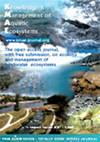How suitable are man-made water bodies as habitats for Odonata?
IF 1.7
3区 环境科学与生态学
Q3 FISHERIES
引用次数: 17
Abstract
Many studies have reported a negative impact of freshwater habitat modification on biota. Nevertheless, some man-made water bodies have proven to be valuable for biodiversity conservation as they can harbour many species. We investigated 36 man-made water bodies to determine their suitability as habitats for Odonata. Larvae were sampled in littoral, during the summer months of 2016 and 2017. At each sampling site, ten samples were collected using a benthos hand net. A total of 21 Odonata species was recorded. Odonata assemblages mainly consisted of common widespread species. Yet, at Vlačine Reservoir, located in the Dinaric Western Balkan ecoregion, we also recorded a rare and endangered Mediterranean species,Lindenia tetraphylla(Vander Linden, 1825). Aquatic and riparian vegetation, water level fluctuations and dissolved oxygen concentration had the highest influence on Odonata, showing that man-made water bodies with a well-developed riparian zone and aquatic vegetation, and with low daily and seasonal water level fluctuations, can provide suitable habitats for diverse Odonata species. Odonata are among the sensitive freshwater insects widely used as ecological indicators and umbrella species, therefore these results about their assemblages in heavily modified and man-made habitats could contribute to future conservation activities of freshwater biota and habitats.人造水体是否适合作为水豚的栖息地?
许多研究报告了淡水生境改变对生物群的负面影响。然而,一些人造水体已被证明对生物多样性保护有价值,因为它们可以容纳许多物种。我们调查了36个人工水体,以确定它们作为水豚栖息地的适宜性。在2016年和2017年夏季,在沿海地区取样了幼虫。在每个采样点,使用底栖动物手网收集了10个样本。共记录到蜥目动物21种。齿蛙类主要由常见的广布种组成。然而,在位于Dinaric西巴尔干生态区的vlaine水库,我们还记录了一种稀有和濒危的地中海物种Lindenia tetraphyla (Vander Linden, 1825)。水生和河岸植被、水位波动和溶解氧浓度对水蜥的影响最大,说明河岸带和水生植被发达、日水位波动和季节水位波动小的人工水体可以为多种水蜥提供适宜的栖息地。大腹蛇是一种敏感的淡水昆虫,被广泛用作生态指标和保护伞类,因此,这些研究结果可以为未来的淡水生物群和栖息地保护活动提供参考。
本文章由计算机程序翻译,如有差异,请以英文原文为准。
求助全文
约1分钟内获得全文
求助全文
来源期刊

Knowledge and Management of Aquatic Ecosystems
环境科学-海洋与淡水生物学
CiteScore
3.70
自引率
5.60%
发文量
22
审稿时长
>12 weeks
期刊介绍:
Knowledge and Management of Aquatic Ecosystems (KMAE-Bulletin Français de la Pêche et de la Pisciculture since 1928) serves as a foundation for scientific advice across the broad spectrum of management and conservation issues related to freshwater ecosystems.
The journal publishes articles, short communications, reviews, comments and replies that contribute to a scientific understanding of freshwater ecosystems and the impact of human activities upon these systems. Its scope includes economic, social, and public administration studies, in so far as they are directly concerned with the management of freshwater ecosystems (e.g. European Water Framework Directive, USA Clean Water Act, Canadian Water Quality Guidelines, …) and prove of general interest to freshwater specialists. Papers on insular freshwater ecosystems and on transitional waters are welcome. KMAE is not a preferred journal for taxonomical, physiological, biological, toxicological studies, unless a clear link to ecological aspects can be established. Articles with a very descriptive content can be accepted if they are part of a broader ecological context.
 求助内容:
求助内容: 应助结果提醒方式:
应助结果提醒方式:


